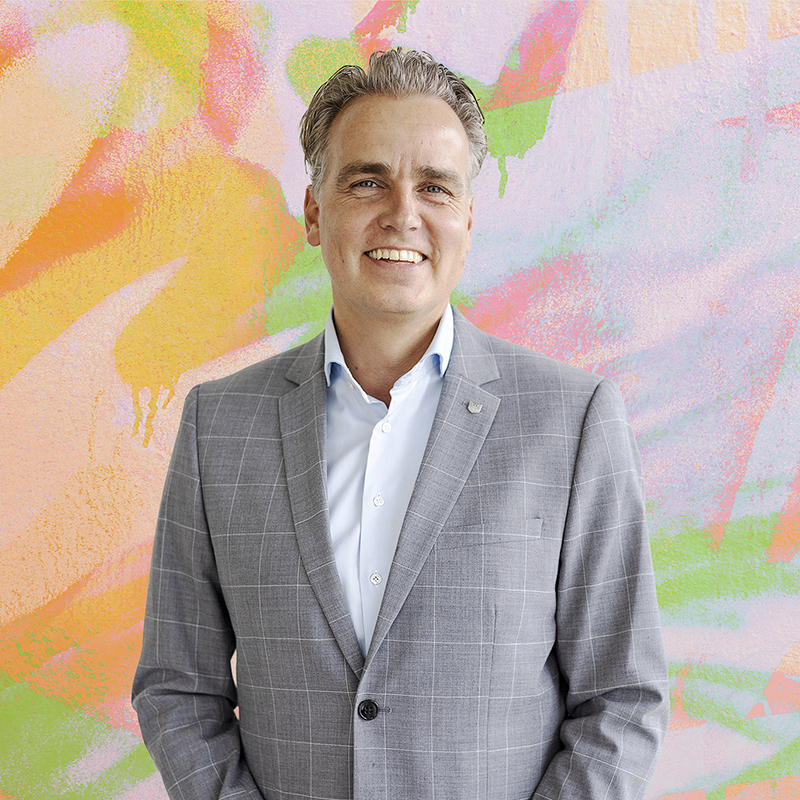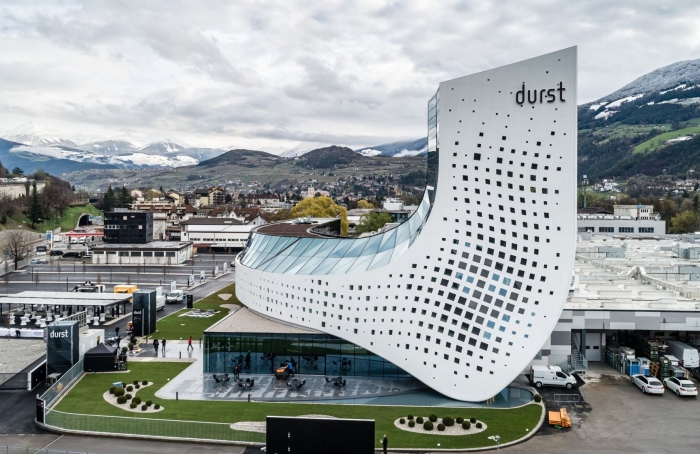Eco blah, blah. That’s what so many of us hear when it comes to environmental input, because the global focus on the issue means everyone has to say something about it, even if it’s really nothing of any real meaning. So what do wide-format print kit manufacturers have to say?
Ever asked detailed questions of your kit suppliers in terms of their environmental policies and how those impact their large-format systems R+D, parts sourcing, manufacturing, warehousing locations and shipment, servicing etc.? We have, because the time is coming when such circular economy considerations mean we need to know. But are the manufacturers ready to answer in sufficient detail to make the conversation worthwhile? As you’ll see from the feedback below, some manufacturers are more prepared to have that involved talk than others - and some still not at all, well, not beyond the ‘everything we do is eco conscious’ rote response. Here’s what some of the more responsive had to say.

"Our Arizona and Colorado printers are designed with the circular economy in mind and are eligible for remanufacturing after their first lifetime"
Wouter Derichs, Canon
At Canon, as we’ve oft been told, the vision is to operate according to the Kyosei philosophy, which means living and working together for the common good. According to Wouter Derichs, sales and marketing director, large format graphics, EMEA, Canon Production Printing, that means striving to nurture the environment, conserve energy and resources - and it means contributing toward the United Nations Sustainable Development Goals of creating a more sustainable present and future by managing environmental impacts.
Drilling down to how Canon’s eco practices impact its large-format print business, take for instance the opening in 2020 of a new head office in Venlo, Netherlands, (adjacent to Canon Production Printing’s R&D and manufacturing sites). Located in a forest, the building has been built with respect to its green surroundings, solar cells support electricity generation, and there are hot and cold-water storage, heat pumps and climate ceilings.
In terms of manufacturing and recycling Derichs says: “The company aims to minimise the use of natural resources and design waste. We also ensure that we prolong the use of products at the end of their life cycle where possible. We are committed to reducing reliance on natural resources - choosing long life parts and using recyclable materials were possible, such as steel and iron. And our Arizona and Colorado printers are designed with the circular economy in mind and are eligible for remanufacturing after their first lifetime. This allows us to work with our customers to maximise their own sustainability commitments.”
He points out too that Canon’s large-format graphics printers are also influenced by the need to print consistently well on recycled materials and more sustainably derived materials.
Derichs continues: “As part of our manufacturing, we produce large and heavy parts in-house. This results in lower transport distances and lower stock levels - this in turn helps to reduce our carbon footprint. Our robust designs also help us to ensure a long product lifetime and our practices, which support the circular economy, include local regional refurbishments, factory remanufactured models, and the reuse of service components and parts. At the end of the extended life-time, we operate a centralised dismantling process which reverts devices back to their raw materials.”
When it comes to manufacturing and logistics in relation to consumables, Dericks says: “We have significantly increased our ink production in line with the growing volumes of the large-format roll-to-roll market. Our new production facility is designed to be as environmental friendly as possible, focusing on operational efficiencies as well as on delivering high energy savings. With the help of inline statistical processes, we ensure first time right material processing. Raw materials are dosed in an automated way into our processing vessel, resulting in no spillage of materials. We also produce products based on customer orders to avoid over-processing.
“We strive to minimise the amount of waste in the production process with the only waste stream being the filters that we have to use. We avoid the need to rinse away the remains of the previous ink of a different colour, as our inks are produced in colour specific lines, so virtually no waste is generated during changeover. Additionally, our material packaging (cardboard for the boxes and labels) is made from recycled materials.”
He adds: “As demands increase for sustainable products and regulations evolve, we strive to ensure that we use materials that support the circular economy. With this in mind we actively research our materials with commercial and academic partners - helping to improve the strength of our eco-base for our UV and UVgel inks.”
The UV inks used in Arizona flatbed printers, and UVgel technology used in the Colorado roll-to-roll printers, support the environment in the following ways: both products are free of Hazardous Air Pollutants (HAPs) and Volatile Organic Components (VOCs) and have been awarded the UL Greenguard Gold certificate; the durable nature of the inks means lamination can be omitted; the printers are equipped with filters and can be installed and operated without dedicated extraction - and the radiation emitted whilst in operation is also below the threshold limit values for UV, visible and IR radiation, according to ACGIH institute standards.
Sustainability is also a key consideration when it comes to Canon’s service and remote support offering. “Unnecessary onsite service visits are avoided and we minimise travel where possible - whilst ensuring machine uptime at customer sites. We reduce the number of onsite visits by utlising preventive maintenance activities, based on smart predictive analysis. Furthermore, our service training is a mix of virtual and in-person training which also helps to minimise unnecessary travel,” stresses Derichs.

At Durst’s headquarters in the south Tyrol things come full circle with the mountain habitat and the aim of focusing not just on the machines but also on the people behind them.
Durst has built a reputation for having an ecological and sustainable approach, which like Canon’s, is entrenched in its corporate philosophy. Peter Bray, MD, Durst UK and Ireland, says: “It is our clear target to offer the most sustainable digital print technologies to our customers. This starts with considering the ink technologies but also considers minimum substrate waste when feeding the machine and minimum waste generation, energy and water consumption in the machine manufacturing itself.
“Every technical solution we provide is evaluated to ensure the least harm for people and the environment, which is why, for example, solvent and eco-solvent concepts have never been pursued within our graphics businesses.”
Bray continues: “A key mission is looking after our environment and having a small carbon footprint. At Durst we offer complete solutions from pixel to output, and at our headquarters in the south Tyrol things come full circle with the mountain habitat and the aim of focusing not just on the machines but also on the people behind them.”
He adds: “For the last few years also greening-up the print substrates has come into the spotlight in the industry. Numerous suppliers are providing print substrates from recycled materials (fibers, polymers, etc.) but are also starting to engage in the field of ‘post-print recycling’. In the latter case, however, only few and strongly application/material-dependent standard procedures are in place to assess the recycling capabilities of (printed) substrates. It can be expected that much more standardised testing procedures for recycling will come up in the next years - also with a special focus on inkjet-printed recycled media. Currently, several institutes and universities are focusing on this topic.”

Epson has worked for many years to increase the energy efficiency of its production processes and products, improve resource efficiency, and eliminate harmful and hazardous substances. And it’s making giant strides to go ever further, researching new ways to minimise the environmental impacts incurred by customers using Epson products and to raise operational efficiency and productivity.
To that end it committed to spending 100bn yen during 2020-2030 to reduce GHG emissions in the supply chain by more than 2m tonnes and meet 100% of the electricity needs of the entire Epson Group by 2023 with use renewable energy. It’s also concentrating management resources on the development of products and services that reduce environmental impacts. The latter is part of its ‘Better Products for a Better Future’ commitment, where it strives to create products that are reliable, recyclable and energy efficient.
Epson contributes to the formation of a circular economy in which waste is minimised, by working to reduce emissions and preserve water resources in its production processes. It also promotes the efficient use of limited resources by making products smaller and lighter, by collecting and recycling end-of-life products, and by developing digital inkjet printing solutions.

"Epson defines an ‘eco-considerate’ product as one for which environmental impacts are considered from product conception to mission completion"
Phil McMullin, Epson
As Phil McMullin, pro graphics sales manager, Epson UK, points out, Epson defines an ‘eco-considerate’ product as one for which environmental impacts are considered from product conception to mission completion - that is, at every phase of the life cycle, from design and manufacturing to transport, usage, and recycling.
With regards to its large-format solutions Epson is using post-consumer recycled material in the printer’s plastic and equipping the machines with high-capacity ink tanks (people who print a lot and use larger-sized ink bottles instead of ink cartridges can reduce their CO2 emissions from consumables by about 73% according to McMullin).

"In all of our locations around the world we’re implementing multiple sustainability initiatives"
Antonina Realmuto, Fujifilm
At Fujifilm Antonina Realmuto was appointed group sustainability director, ink solutions group, just last year “as evidence of how seriously the company is investing in long-term solutions to minimise environmental impact and protect the planet,” she says.
“Our approach to achieving this is twofold - working to improve sustainable practices within our own manufacturing and operations, while at the same time working to provide products to our customers that help them to reduce environmental impact, and to pass that benefit onto their customers in turn. In all of our locations around the world we’re implementing multiple sustainability initiatives.”
In the UK that has ramifications for the ink manufacturing facility in Broadstairs, Kent, also the headquarters of the Fujifilm wide format inkjet systems business, responsible for the development of the Acuity and Onset printer ranges. In 2016, Fujifilm installed a solar farm at Broadstairs to generate electricity for production. It was predicted to generate 176,600kWh annually, but is exceeding expectations, with 185,094kWh generated in 2019. “With an extension to this solar installation currently underway, we expect this capacity to increase in the next few years. We are doing our best to fill the energy gap with and the additional energy we require on site to be renewable,” says Realmuto.
“In addition to using an ever-greater proportion of energy from renewable sources, we are also continually working to reduce overall energy use. In 2021 at Broadstairs, we reduced total annual electricity consumption by 1.1 MWHr. Heating onsite has been upgraded to be more energy efficient and LED lighting has been installed across the complex.”
Operations at Broadstairs are transitioning to the use of water-based cleaning solutions for cleaning ink pots used in the manufacture of inks too. “This will reduce our use of potentially harmful solvents. Our new water-based cleaning alternative is made of less than 5% VOC’s we are looking to install this system onsite before the end of the 2021 fiscal year,” Realmuto adds.
In addition, Fujifilm has installed electric car charging ports in Broadstairs site to support workers who have switched to electric vehicles, and even the food in the canteen is sourced locally.
Kevin Jenner, European marketing manager, Fujifilm wide format inkjet systems, says that from a product development perspective, “sustainability benefits are a key aspect of planning and design. An example of efficient product design is the new Fujifilm Acuity Ultra R2 superwide roll-to-roll machine. Among new features is an energy efficient LED curing option and a clever ink container design which is built to accommodate seven litres of ink, which means the whole contents of a standard ink bottle are used when refilling and printers no longer have the irritation of a lot of ink potentially being wasted.”
Steve Davis, EMEA marketing director at Roland DG says: “Sustainability has undoubtedly become a buzzword in today’s printing industry and arguably, one of the biggest emerging trends. With the rise in eco-consciousness, consumers are under increasing pressure to do things more sustainably, with the growing legal and regulatory pressure on businesses to follow suit.
‘In light of this, Roland DG has adopted various ways to cater to the needs of their customer base through environmentally friendly products. Our inks are Greenguard Gold certified and the inks and primers for our Texart printer are Eco Passport certified. In addition, we’ve also opted to reduce energy and resources during each stage of the lifecycle of our products - from design and development to transportation, use and disposal - for a low-carbon and recycling-oriented society’.
SwissQprint has a ‘Greentech’ policy that answers many of the questions the company says it is being asked about its ecological and sustainability practices. For instance, when it comes to
CO2 emissions it points out that its shipping distances are short - 80% of its own suppliers, providing 90% of all machine parts, are Swiss companies and many are located close to its production facilities.
All of its current flatbed and roll-to-roll printers are ‘energy efficient’, as evidenced by ISO 20690:2018 certification. It flags up that the UV printing process requires neither heating nor ventilation, which keeps the energy requirements of its printers low (two electric kettles need the same amount of energy per hour as a Nyala claims SwissQprint) and that the LED lamps they use consume little electricity and have low emissions. Also worth note is that swissQprint products have a service life of up to 12 years. And the company makes a point saying they are low maintenance, minimising service calls and consumable parts that need replacing.
On what seems an appropriate end note, finishing manufacturer Summa said its eco considerations come to fruition in the following ways: its co-operation with a dealer network means there’s local support, cutting travel and thus bringing all the associated eco benefits; bundling shipments means optimal transport logistics; many machine parts are retrofittable so machines can be used multi functionally and can grow with the customer’s business; and everything in the company is recycled as much as possible.
Hopefully, some of your questions will have been answered in the responses provided here. No doubt they have also raised others. Increasingly, manufacturers are going to have to be prepared to answer them. Keep asking until they do.


